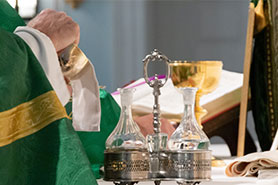Five Things You Didn't Know About The Catholic Chalices
05-27-2020
In Christian traditions, the Holy Catholic Chalice is the vessel or cup used at the Last Supper. The celebration of the Eucharist still retains elements of the Last Supper rituals, including usage of a chalice. Catholic chalices are often purchased for new priests; churches also buy them for special occasions or regular use. You should peruse each chalice for sale - they are truly works of art! While admiring them, you might find the following facts about church chalices interesting:
- The Catholic church requires chalices to be gold or silver. If financial strain or duress is present, then pewter is an acceptable alternative. Catholic chalices for sale have a considerable range in cost, but most churches or priests will invest heavily in this critical church supply.
- Each church chalice requires consecration. When a church buys a chalice for sale, a bishop must perform that rite; the priest cannot. In some cases, an abbot can consecrate a chalice if it is intended for monastic use. It is also worth noting that chalices can lose their consecration (this might occur when it needs repair, for example). They must be re-consecrated once again by a bishop.
- The Catholic chalice symbol is a common emblem for saints. The image of a church chalice conveys that the saint lived by God’s word and promise, “if they drink any deadly poison, it shall not hurt them.” The interpretation is that saints are not hurt by earthly challenge and live in joyful peace with God. Or, more simply, the chalice represents the Last Supper and the saintly commitment of those who ate with Jesus. Two such saints are St. John the Evangelist and St. Barbara.
- Chalices hold wine, or the blood of Christ. Many wonder why some parishes or individuals do not offer or take wine from the Catholic chalice. The Roman Catholic church states that communion of bread alone suffices for full Eucharist. Many churches choose not to offer wine for two common reasons. Firstly, if the congregation is big, offering both can cause Mass to run too long. Secondly, the body of Christ is easily recoverable should a host drop or endure harm in any way. On the other hand, the blood of Christ is difficult to recover if the consecrated wine is spilled.
- Many churches participate in a “traveling chalice” program. The congregation’s chalice goes home with a parish family each week. While the Catholic chalice is in their possession, they are encouraged to pray fervently for vocations. The intention is for the chalice to be in a home for 52 weeks with many, many prayers offered for vocation.
Hope this bit about Catholic chalices helped you learn more about church supplies and chalices!

